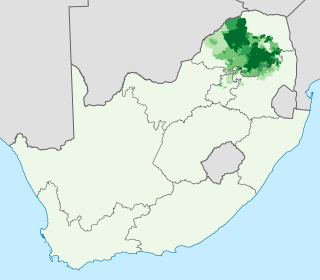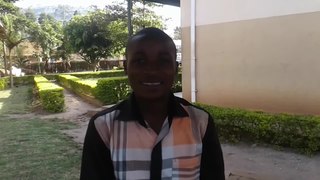Classification
Kgalagadi (also rendered Kgalagari, Kgalagarhi, Kgalagari, Khalagari, Khalakadi, Kxhalaxadi, Qhalaxarzi, Shekgalagadi, Shekgalagari, Kqalaqadi) is most closely related to Tswana, and until recently was classified as a dialect of Tswana. [2]
Dialects include Shengologa, Sheshaga, Shebolaongwe, Shelala, Shekhena, Sheritjhauba and Shekgwatheng.

Sesotho sa Lebowa is a Sotho-Tswana language group spoken in the northeastern provinces of South Africa, most commonly in Mpumalanga, Gauteng and the Limpopo provinces. It is erroneously commonly referred to in its standardised form as Pedi or Sepedi and holds the status of an official language in South Africa.

Tswana, also known by its native name Setswana, and previously spelled Sechuana in English, is a Bantu language spoken in and indigenous to Southern Africa by about 8.2 million people. It is closely related to the Northern Sotho and Southern Sotho languages, as well as the Kgalagadi language and the Lozi language.
SothoSesotho, also known as Southern Sotho or Sesotho sa Borwa is a Southern Bantu language of the Sotho–Tswana ("S.30") group, spoken in Lesotho, and South Africa where it is an official language.
ǂʼAmkoeAM-koy, formerly called by the dialectal name ǂHoan, is a severely endangered Kxʼa language of Botswana. West ǂʼAmkoe dialect, along with Taa and Gǀui, form the core of the Kalahari Basin sprachbund, and share a number of characteristic features, including the largest consonant inventories in the world. ǂʼAmkoe was shown to be related to the Juu languages by Honken and Heine (2010), and these have since been classified together in the Kxʼa language family.
The Saho language is an Afro-Asiatic language spoken in Eritrea, Sudan and Ethiopia. It belongs to the family's Cushitic branch.
Naba is a Nilo-Saharan language spoken by approximately 500,000 people in Chad. Those who speak this language are called Lisi, a collective name for three closely associated ethnic groups, the Bilala, the Kuka and the Medogo, that represent the three dialects in which Naba is subdivided. They live mainly in the Batha Prefecture, but the Kuka are also in Chari-Baguirmi. Ethnologue estimates the lexical similarity among the three dialects to be no less than 99%. Arabic is often spoken as a second language.

Kiga is a Great Lakes Bantu language of the Kiga people (Bakiga). Kiga is a similar and partially mutually intelligible with the Nkore language. It was first written in the second half of the 19th century. Kiga is largely spoken in the ancient Kigezi region which includes about 5 districts, namely Rubanda, Rukiga, Kabale, Kanungu and some parts of Rukungiri. As of 2021, Kiga is spoken natively by about 1.3 million people in Uganda.

Sanumá or Sanöma is a Yanomaman language spoken in Venezuela and Brazil. It is also known as Sanema, Sanima, Tsanuma, Guaika, Samatari, Samatali, Xamatari and Chirichano. Most of its speakers in Venezuela also speak Ye'kuana, also known as Maquiritare, the language of the Ye'kuana people the Sanumá live alongside in the Caura River basin.
Yeyi is a Bantu language spoken by many of the approximately 50,000 Yeyi people along the Okavango River in Namibia and Botswana. Yeyi, influenced by Juu languages, is one of several Bantu languages along the Okavango with clicks. Indeed, it has the largest known inventory of clicks of any Bantu language, with dental, alveolar, palatal, and lateral articulations. Though most of its older speakers prefer Yeyi in normal conversation, it is being gradually phased out in Botswana by a popular move towards Tswana, with Yeyi only being learned by children in a few villages. Yeyi speakers in the Caprivi Strip of north-eastern Namibia, however, retain Yeyi in villages, but may also speak the regional lingua franca, Lozi.
Rendille is an Afro-Asiatic language spoken by the Rendille people inhabiting northern Kenya. It is part of the family's Cushitic branch.

Gun is a language in the Gbe languages group. It is spoken by the Ogu people in Benin, as well as in south-western Nigeria. Gun is part of the Fon cluster of languages inside the Eastern Gbe languages; it is close to Fon, especially its Agbome and Kpase varieties, as well as to the Maxi and Weme (Ouémé) languages. It is used in some schools in the Ouémé Department of Benin.

The Tharu or Tharuhat languages are any of the Indo-Aryan languages spoken by the Tharu people of the Terai region in Nepal, and neighboring regions of Uttarakhand, Uttar Pradesh and Bihar in India.
Mundang is an Mbum language of southern Chad and northern Cameroon.
Eastern Pwo or Phlou, is a Karen language spoken by Eastern Pwo people and over a million people in Myanmar and by about 50,000 in Thailand, where it has been called Southern Pwo. It is not intelligible with other varieties of Pwo, with which it shares 63 to 65% lexical similarity. The Eastern Pwo dialects share 91 to 97% lexical similarity.
Gwari is a Nupoid language spoken by the Gbagyi people, which make up over a million people in Nigeria. There are two principal varieties, Gbari and Gbagyi, which have some difficulty in communication; sociolinguistically they are distinct languages.
Kaba (Kabba), or Kabba of Goré, is a language of the Sara people in Central African Republic and Chad, with around 100,000 speakers.
Yamdena is an Austronesian language of Yamdena and surrounding islands in the Maluku Islands in Indonesia. In 1991 there were an estimated 25,000 speakers of the language. Current BPS data has the present number of speakers at 69,000.
Kayan is a dialect cluster spoken by the Kayan people of Borneo. It is a cluster of closely related dialects with limited mutual intelligibility, and is itself part of the Kayan-Murik group of Austronesian languages.
Mengen and Poeng are rather divergent dialects of an Austronesian language of New Britain in Papua New Guinea.
Ot Danum is a Barito language of the central Borneo, Indonesia, spoken by the Ot Danum people. Dialects include Cihie and Dohoi.





